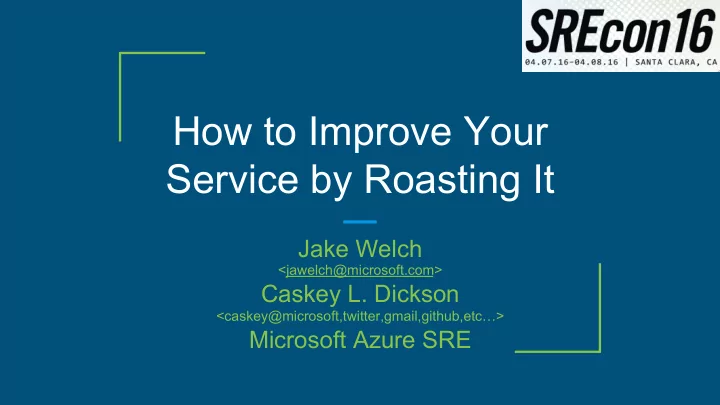

How to Improve Your Service by Roasting It Jake Welch <jawelch@microsoft.com> Caskey L. Dickson <caskey@microsoft,twitter,gmail,github,etc … > Microsoft Azure SRE
Brief History of SRE @ Azure • 2008 Azure Public Launch • 2008 - 2014 Divergence of DevOps approaches • 2014 SRE Pilot started • 2015 Dedicated SRE organization formed Enter the challenge of adapting SRE in an established organization
Engaging with Product Teams • How do you get a product team to open up and work with you? • Only they know where debt lies, what it looks like, where their service fails • Is there a common understanding of SRE, agreement on goals? We can't help you if you won't tell us where it hurts
Service Roast Pronunciation: \ ˈ s ə r-v ə s\ \ ˈ r ō st \ n. A series of meetings at which a service is subjected to good-natured but frank discussions to uncover design/ process flaws, scale limits or other shortcomings
What is a Service Roast? Goal: Expose and understand the warts, wrinkles, design flaws, shortcomings and problems everyone knows a service has but doesn’t want to talk about Covers the entire service lifecycle from Development to Disaster Recovery Output: List of flaws, issues, opportunities for improvement, and understanding You can and should do this for SRE services!
Why Do This? • Builds relationships and trust between the teams • SRE learns about the service • Dramatically speeds up ‘newbie to expert’ process • Exposes details that otherwise would be difficult (or painful) to learn of • Creates a shared backlog of improvements
Guidelines: Working Together Requires investment from SRE and product teams: everyone is there to participate • Get real contributors in the room (go away managers) • Put away phones, laptops • End to end process requires ~10 hours • Meet over several weeks, not a single day • More than 1 hour is too long; 45 minutes works well
Guidelines: Tone Successful engagement requires clarity of purpose and tone • Not an attack on the service • Not a judgment of past choices • Focus on ‘How’ questions not ‘Why’ questions Why’s can be seen as judgmental • Every participant must understand this
Example Questions ✘ Why did/didn’t you … ? ✔ How does ${feature} work? ✘ Why don’t you instead … ? ✔ When do these two pieces communicate? ✘ Why can’t you just … ? ✔ What part of the system handles ${feature}? ✘ Why aren’t you simply … ? ✔ Where are user requests routed?
Roles • Service Owners SME experts on service providing insights • Roast Participants Ask questions, gain clarity on service • Scribe Keeps track of interesting tidbits, actions, learnings • Moderator Impartial observer not otherwise involved in the engagement
The Moderator • A designated impartial observer • Focuses on tone and body language of participants • Monitor language to avoid attacks • De-escalate conversations as necessary • Decides when to call the meeting off Strongly recommend implementing this role
Meeting Agenda Choose a single area or subsystem to drill into • Moderator provides overview of guidelines and sets tone • Area SME kicks off with an overview using whiteboards, diagrams as needed • Sessions are interactive: ask questions, clarify, dispel misinformation • Moderator keeps conversation on topic • Scribe keeps track of off-shoots for future meeting topics
Service Roast Sample Topics • Service overview: What is it, who uses it, where does it fit in overall • Architectural overview - confirm up and downstream dependencies • Development process - tools, source control, library dependencies, build, test • Capacity planning - how do you scale, how do you load test? • Deployment & configuration management practices • Monitoring, Logging, Diagnostics • SLAs, SLOs, KPIs, etc. • Production playbook, disaster recovery/high availability, backup/restore
Meeting Closure • At the end of the meeting, the next topic is chosen and adjustments are discussed for future sessions (new topics, participants, etc.) • After each meeting, the scribe summarizes key learnings and opportunities identified in a centralized doc • At the end of the series, the identified items should be jointly prioritized for bugs/tasks opened
Gotchas • Things can be said in the room that don’t leave (except the fix) • Don’t do this if you think it will degrade relationships between the teams • Each service will be at a different maturity point in each area - that’s ok! • Don’t compare one service to another • When the product team is talking to each other, don’t stop them - listen harder
Summary • A Service Roast can be a great tool to safely gain E2E service understanding • Expectations and tone are critical success components • Managing emotions is critical to a safe discussion environment • Multiple, 45 minute meetings are best to cover all areas • The moderator role helps smooth over bumps in the process
Questions ?
Recommend
More recommend